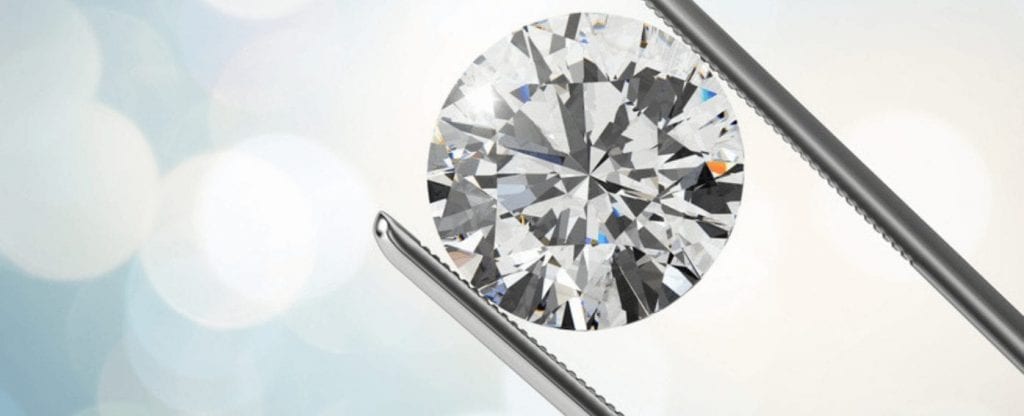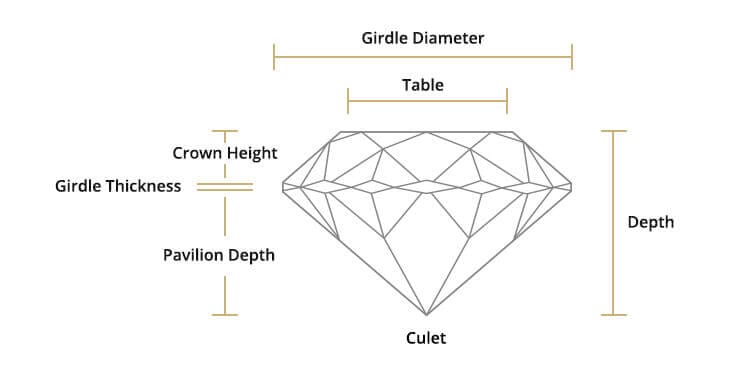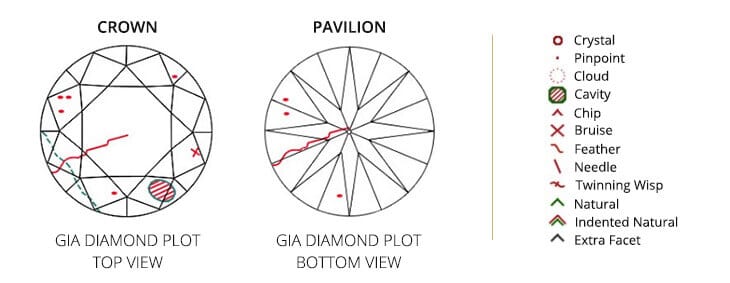
Abrasion – A small scratch on a diamond’s surface.
Asscher Cut – A fancy shaped diamond with a squared shape and prominently cut corners. Asscher cut diamonds have straight, step-like facets similar to those exhibited by emerald cut diamonds.
Bearded Girdle – A girdle that exhibits a number of tiny, hair-like fractures that extend into the diamond
Bezel Set – In a bezel setting, the diamond or other stone is secured to its mounting via a thin strip of metal rather than prongs. Bezel settings can be of any shape.
Blemish – Blemishes are often seen on diamond surfaces. These external characteristics include abrasions, nicks, extra facets, polish marks, naturals, and scratches. Many are not visible to the naked or untrained eye.
Brilliance – The intensity of the white light perceived by the eye when viewing a diamond’s crown, including from external and internal reflections. Clarity, polish, proportions, symmetry, and the quality of workmanship are factors that contribute to a diamond’s brilliance.
Brilliant Cut – A round-cut diamond that features triangular and kite-shaped facets that extend from the stone’s center to the girdle edges of its crown and pavilion.
Bruise – An imperfection that breaks a diamond’s surface. Usually the result of the diamond hitting a hard surface.
Carat – One carat equals 0.2 grams (200 milligrams). This is a measure of weight rather than size (See: Carat weight vs. total carat weight).
Cavity – A tiny opening that breaks a diamond’s surface.
Channel Set – A setting style that features two parallel walls that hold diamonds and other stones in place, with no metal between the stones.
Chip – A jagged, shallow break that affects value and poses a potential durability problem.
Clarity – A rating that affects price and beauty, and that describes the relative absence of blemishes and/or inclusions in a diamond (see: diamond clarity can it be identified with the naked eye).

Cleavage – A breakable weak point or fracture, usually caused by weak molecular structure. A cleavage is likely to split if struck in a certain direction, and in uncut diamonds, it is used as a natural site for splitting crystals prior to cutting and polishing.
Cloud – An inclusion that can make a diamond appear hazy or even milky in appearance when viewed under magnification. Most clouds cannot be seen with the naked eye.
Color – A diamond’s tint. Color is determined by comparing each diamond to a set of authenticated master diamonds scaled from colorless (D) to saturated (Z).

Color Origin – The basis of a colored diamond’s hue, including natural, enhanced, high temperature, and high pressure treated.
Crown – The angled edge of a diamond or other gemstone, located between the girdle plane and table (top).
Culet – A diamond’s bottom facet, located at its tip. Not all diamonds have culets.
Cushion-Cut – A brilliant-cut
rectangular or squared diamond shape with curved sides, and rounded corners. See our complete guide to cushion cut diamonds.
Cut – A diamond’s surface features precisely proportioned facets that largely determine its beauty by emphasizing dispersion, brilliance, and scintillation, or by maximizing its size.

Depth – A diamond’s height, measured in millimeters from its point or culet to its table.
Dispersion – Also known as “fire,” dispersion refers to the separation of white light into different colors.
Durability – A diamond’s ability to resist wear, based on its toughness, stability, and hardness.
Emerald Cut – A square or rectangular cut diamond with diagonal corners. Most emerald cut diamonds have between two and four rows of facets that lie parallel to the girdle.
Eye Clean – A term that indicates that a diamond has no flaws that are visible to the naked eye when viewed face up, 12 inches from the viewer.
Facet – Any flat, polished surface on a diamond or other gemstone.
Fancy – Shapes other than single cut or round brilliant cut are considered to be “fancy.” Hearts, ovals, pears, and marquise shapes are examples.

Feather – A small fracture inside a diamond, sometimes extending to its surface and sometimes completely enclosed.
Fingerprint – Any unique identifying characteristic on a diamond
Fire – Flashes of spectral color that reflect from a diamond’s interior when it is moved while being exposed to light.
Flaw – Any internal or external imperfection; most diamonds have flaws.

Fluorescence – Certain diamonds exhibit colored luminescence (usually blue) when exposed to strong sunlight or ultraviolet light. All you need to know about diamond fluorescence.
Four Cs – Also known as the 4Cs, these features include cut, color, clarity, and carat weight. They are used to evaluate and compare diamonds.
Girdle – A diamond’s girdle sits above the pavilion and beneath the crown. It is sometimes rough, but more often is faceted or polished.
Graining – Lines that show the crystal structure’s growth pattern. Sometimes visible on a diamond’s external surface, and sometimes visible internally.
Hardness – A diamond’s ability to resist scratches
Heart Cut – A brilliant cut diamond with a heart shape; pointed at one end with two rounded edges separated by a “V” shape at the other. See all unique diamond shapes.
Inclusion – A catch-all phrase describing imperfections and other flaws. Most diamonds have inclusions.
Knot – A type of inclusion in which one diamond crystal is lodged inside a larger diamond crystal.
Marquise Cut – A brilliant cut diamond shape that features two curved sides and tapered, pointed ends. Most marquise diamonds are brilliant cut. See all unique diamond shapes.
Melee – A group of gemstones including diamonds, usually used to accent a larger stone and typically weighing .12 carats or less.
Mine Cut – Sometimes called an “old mine cut” diamond, round to rectangular shaped, with a small table, a high crown, and a large culet.
Needle – A thin, rod-shaped inclusion.
Old European Cut – Typically exhibited by some antique diamonds, the old European cut features a small table, a heavy crown, and remarkable depth.
Oval Cut – A brilliant cut diamond shape with curved sides and rounded ends.
Pavilion – The faceted, steeply angled bottom portion of a diamond that typically sits below the mounting. It is located just below the girdle.
Pear Shape – A brilliant cut diamond with one wide, rounded end and one pointed end.
Plotting Diagram – a schematic that approximates the shape and style of a diamond while also noting its internal and external characteristics.
Point – A weight measurement equal to 1/100 carat. For example, 0.80 carats equals 80 points.
Princess Cut – A brilliant cut diamond shaped like a square or rectangle, with pointed corners. Check these 6 outstanding Princess Cut diamond engagement rings sold at Worthy.
Radiance – The amount of light refracted and reflected by a diamond, also referred to as “life” or “sparkle.”
Radiant Cut – A brilliant cut fancy rectangular or square shaped diamond with its corners cut off. Read Worthy’s guide to radiant cut diamonds.
Rough Diamond – An uncut, unpolished diamond.
Round Brilliant Cut – A traditional round diamond, usually with 57 or 58 facets.
Scintillation – The mirrorlike reflections a diamond’s facets make when it is turned while being exposed to light.
Solitaire – Jewelry containing just one diamond or gemstone, i.e. a solitaire engagement ring. Diamond solitaire ring trends.

Symmetry – A diamond’s overall uniformity, which ranges from poor to ideal.
Table – The largest, uppermost surface of a cut diamond.
Trilliant Cut – A brilliant cut three-sided diamond shape, sometimes called a triangle cut. Sides may be of equal or unequal length.
Twinning Wisp – An irregular, ribbon-like inclusion inside a diamond
Wisp – A thin, curved inclusion that can appear hair-like or cloud-like
X-Ray Fluorescence – A diamond’s ability to emit secondary x-rays when it is exposed to an x-ray. This characteristic is used to identify a diamond or other stone by indicating its chemical elements.
©2011-2025 Worthy, Inc. All rights reserved.
Worthy, Inc. operates from 25 West 45th St., 2nd Floor, New York, NY 10036